
This chapter discusses some of the most important hazards that you find on weatherization jobs in residential buildings. The SWS contains many health-and-safety requirements that relate to various cost-effective energy-conservation measures (ECMs). We reference these SWS requirements throughout this chapter.
The chapter begins with health, safety, and durability of buildings. If health-and-safety problems affect the cost-effective ECMs you select, solve these problems before or during the weatherization work.
Workers are the most important asset of WAP. We discuss their health and safety at the end of this chapter.
Customer Health and Safety
Building fires, moisture problems, carbon-monoxide poisoning, and lead-paint poisoning are the most common and serious health and safety problems found in residential buildings.
Alert residents to any health and safety hazards that you find. Discuss known or suspected health concerns with occupants; take extra precautions based on occupant sensitivity to environmental hazards, such as chemicals and allergens.
✓ Inspect the building for fire hazards such as improperly installed electrical equipment, flammable materials stored near combustion appliances, or malfunctioning heating appliances. Discuss these hazards with occupants, and remove these hazards if possible, as allowed under WPN 17-7.
✓ Understand and comply with the fire-containment code requirements of the IRC.

✓ Test combustion appliances for carbon monoxide and related hazards. Also measure carbon monoxide (CO) in the ambient air. Investigate and eliminate CO.
✓ Find moisture problems, and discuss them with the occupant. Solve moisture problems before or during weatherization work. See page 34.
✓ Obey the EPA Repair, Renovation, and Painting rules when working on buildings constructed before 1978. Prevent dust during all weatherization projects. Explain the lead paint hazard and tell residents what you’re doing to protect them. See page 48.

Worker Health and Safety
In the worker-safety section at the end of this chapter, we discuss the most dangerous hazards present during weatherization and how to avoid these hazards. Hazards include: driving, falls, back injuries, cuts, chemical exposure, repetitive stress, and electrical shocks. See page 55.
1.1 Educate Occupants and Building Operators
Homes and multifamily buildings are complex systems of building envelopes and mechanical systems that harbor a variety of hazards. Educate occupants, landlords, and building operators about the health and safety hazards and the improvements that you make to mitigate these hazards.
✓ Explain any health or safety hazard you see with fellow workers, occupants, and building operators, and discuss how to mitigate the hazard.
✓ Suggest contacting specialists to mitigate particular hazards if appropriate.
✓ Explain equipment operation and maintenance (O&M).
✓ Provide an O&M procedures manuals and manufacturers’ equipment specifications. Encourage occupants or staff to store important documents in a safe and obvious location.
✓ Instruct occupants or staff to remove combustible materials from near ignition sources.
✓ Inform occupants and staff about smoke alarms, carbon monoxide (CO) alarms, and combination alarms, and explain their functioning.
✓ Suggest that occupants or staff remove or isolate indoor air quality hazards such as pesticides, petroleum products, and solvents.
✓ For complex mechanical systems in multifamily buildings, provide signs to inform occupants and building operators about operations, maintenance, and emergency procedures.
The building codes focus on preventing the spread of fire within and between buildings. A fire barrier is a tested and certified wall assembly that can withstand and contain a fire for a particular time duration.
A fire partition is a fire barrier that prevents the spread of fire between the sections of a building. A firewall is a structural fire barrier between buildings that is designed to remain standing during and after a fire.
Flame spread is a tested value of how fast a material burns compared to red oak planks.
A thermal barrier is a sheeting material that protects the materials behind it from reaching a temperature of 250°F or breaching during a fire. Drywall is the most common thermal barrier and is rated for 15 minutes of protection. Fire partitions in multifamily buildings usually require a wall assembly with a 2-hour rating.
An ignition barrier is a material used with foam insulation to prevent the foam from igniting. The code specifies a number of materials that can serve as ignition barriers including drywall, plywood, fibrous insulation, galvanized steel, and intumescent paint.
See also "Fire Testing and Rating" on page 577.
Carbon monoxide is a colorless, odorless, poisonous gas. The two common terms for expressing measured CO concentration are these.
1. “as measured” which compares CO molecules to air molecules in parts per million (ppm).
2. “air free”, which is a value, calculated from the as measured CO and the measured oxygen in combustion gases. Air free denotes what the CO concentration would be in an air-free sample of combustion gases.
The EPA’s suggested maximum 8-hour CO exposure is 9 ppm as measured in room air. Malfunctioning combustion appliances, cigarette smoking, or auto exhaust are the most common CO sources. The EPA’s one-hour CO limit is 35 ppm as measured.
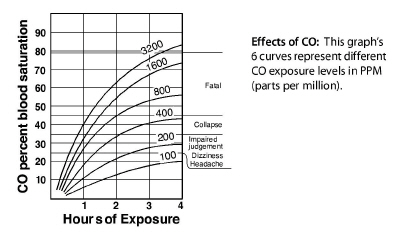
1.3.1 Causes of Carbon Monoxide (CO)
CO is released by unvented gas space heaters, gas-fired domestic water heaters, kerosene space heaters, backdrafting vented space heaters, gas ranges, leaky wood stoves, and motor vehicles idling near the building. Central furnaces and boilers that backdraft may also lead to high levels of CO.
The following conditions cause CO.
• A combustion appliance is overfired compared to its rated fuel input.
• Backdrafting combustion gases smother the flame.
• An object interferes with the flame (a pan over a gas burner on a range top, for example).
• Too-little combustion air.
• Rapidly moving air interferes with the flame.
• Burner misalignment causes a distorted flame.
• Flue or heat exchanger blockage interferes with the flow of flue gases.
Measure CO at the exhaust port of the heat exchanger. Identify and correct CO problems.
Testing for Carbon Monoxide (CO)
The most common CO-test instruments use electronic sensors with a digital display showing parts per million (ppm). Read the manufacturer’s instructions on zeroing the meter — usually by calibrating the meter in outdoor air. CO test equipment must usually be re-calibrated every 6 months, using factory-specified procedures.
Air-free CO measurement includes both CO and O2 sensing with a calculation to find the CO concentration in undiluted flue gases that contain no oxygen. Air-free CO measurement avoids the perception that moving the testing probe or diluting CO are solutions to elevated levels of CO. See "Carbon Monoxide (CO) Testing" on page 283.
Technicians must test for CO both before and after weatherization.
1.4 Smoke and Carbon Monoxide (CO) Alarms
|
SWS Detail: 2.0101 Smoke Alarms; 2.0102 Carbon Monoxide (CO) Alarms |
Every dwelling should have at least one working smoke alarm. CO detectors must be installed in any dwelling unit that does not have a working CO detector. Install these alarms on each conditioned level, near the bedrooms.
Install CO alarms and smoke alarms, or combination CO/smoke alarms, in dwellings that lack both smoke alarms and CO alarms.
Don’t install alarms within 15 feet of gas ranges or combustion devices because small amounts of smoke or CO can cause nuisance false alarms.
Single-function alarms or combination alarms can interconnect electrically for whole-building protection. If one alarm sounds the other alarms sound too.
If hard wired, a licensed electrician must install the alarm.
1.4.1 Occupant Education about Alarms
✓ Educate occupants about what to do if the alarm sounds: evacuate or at least investigate.
✓ Alert residents to the possibility of false alarms from smoking, cooking, dust, and forest fires.
✓ Discuss the low-battery chirping sound and how to replace the battery.
✓ Tell residents that alarms last less than 10 years and that a different sound will alert them when the alarm fails.
|
SWS Detail: 2.0101.1 Hardwired (interconnected) Smoke Alarms |
Install smoke alarms labeled UL 217 in buildings where they don’t exist or don’t work.
✓ Install one smoke alarm in each dwelling on each floor.
✓ If mounted on a wall, mount the alarm from 4 to 12 inches from the ceiling.
✓ If mounted on a ceiling, mount the alarm at least 6 inches from the nearest wall.
✓ If battery powered, prefer long-life lithium batteries.
✓ If hard wired, connect the alarm to a circuit that is energized at all times.
Don’t install smoke alarms in these situations.
• Within 12 inches of exterior doors and windows.
• Within 20 feet of a stove or oven.
• Within 3 feet of a bathroom door.
• With an electrical connection to a switched circuit.
|
SWS Detail: 2.0102.1 CO Detection and Warning Equipment |
Install at least one CO alarm on each habitable floor of all weatherized dwellings or weatherized apartments. CO alarms must comply with these specifications.
✓ Have a label with a UL 2034 listing.
✓ If hard wired, connect to a circuit that is energized at all times by plugging in to an electrical receptacle.
✓ If battery powered, prefer long-life lithium batteries.
✓ Have a digital display of the CO measurement.
✓ Have a sensor-life alarm.
Don’t install CO alarms in these situations.
• In a room that may get too hot or cold for alarm to function properly
• Within 5 feet of a combustion appliance, vent, or chimney
• Within 5 feet of a storage area for vapor-producing chemicals
• Within 12 inches of exterior doors and windows
• Within a furnace closet or room
• With an electrical connection to a switched circuit
• Less than 15 feet away from a gas range.
Gas ovens can release CO, natural gas, or propane into a kitchen. Test the burners for safe combustion with these steps and do the recommended improvements.
1. Test for gas leaks in the gas piping in and around the range and oven and seal leaks.
2. Check oven for stored items. Turn the oven burner and then range burners to high one-by-one. Inspect the flames and test them for CO. For the oven burner test at its outlet. For range burners, hold the test probe at least 8 inches above the flame.
3. If the CO reading is over 225 ppm clean and tune the burner.
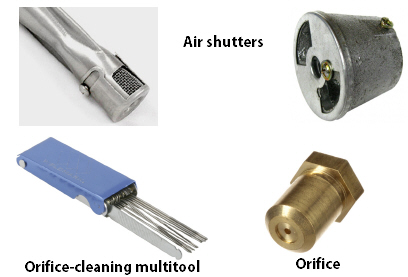
4. Burner orifices can clog. Clean dirty orifices with a multi-tool designed for cleaning various sizes of orifices.
5. Adjust the burner’s air shutters to stabilize and harden the flame and reduce yellow-tipping, which should also reduce the CO concentration.
6. If the CO reading remains over 225 ppm as measured, consider further measures. These include: scheduling a service call by a gas specialist; installing a kitchen fan if none currently exists; or installing an additional CO alarm near the kitchen but at least 20 feet away from the range.
Caution: To protect yourself and the occupants, measure CO in the ambient air in the kitchen during these tests. If the ambient CO reading is 35 ppm or more, discontinue the testing.
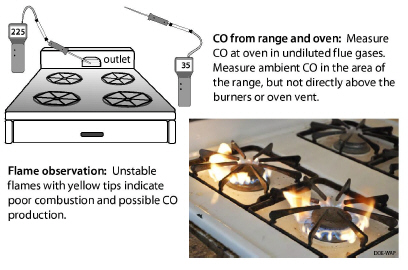
Client Education about Ranges
Educate clients about the following safety practices in using their gas range.
✓ Never use a range burner or gas oven as a space heater.
✓ Open a window, and turn on the kitchen exhaust fan when using the range or oven.
✓ Never install aluminum foil around a range burner or oven burner because the foil could interfere with the flame.
✓ Keep range burners and ovens clean to prevent dirt from interfering with combustion.
✓ Burners should display hard blue flames. Call a service company if you notice yellow flames, white flames, wavering flames, or noisy flames.

1.6 Reducing Moisture Problems
|
SWS Detail: 2.0201 Drainage; 2.0202 Ground Vapor Retarders; 2.0203 Space Conditioning |
Moisture causes billions of dollars worth of respiratory distress, property damage, and high energy bills each year in American buildings. Moisture-nurtured pests, such as dust mites and mold, cause respiratory illness.Water damages building materials by nurturing destructive pests like mold and insects, dissolving glues and mortar, and corroding metal.
1.6.1 Moisture Sources and Effects
Water or material wetting due to high relative humidity reduces the thermal resistance of insulation and other building materials. High humidity also increases air-conditioning costs because the air conditioner must remove airborne moisture to provide comfort.
The most common sources of moisture are leaky roofs and damp foundations. Other critical moisture sources include clothes dryers venting indoors, long showers, cooking, and unvented gas appliances like ranges or decorative fireplaces. Clients control many of these moisture sources, so educate them about how to reduce moisture sources.
Climate is also a major contributor to moisture problems. The more rain, extreme temperatures, and humid weather a region experiences, the more its buildings are vulnerable to moisture problems.
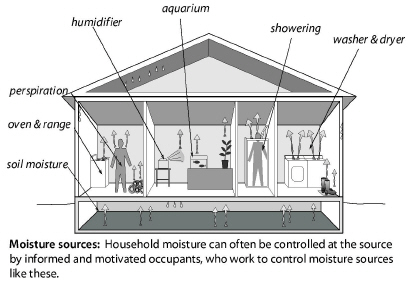
1.6.2 Moisture Reduction Priorities
Follow these priorities by number to reduce moisture problems.
1. Reduce moisture sources such a roof leaks, plumbing leaks, and standing water around the building’s perimeter outdoors.
2. Install air and vapor barriers to prevent water vapor from migrating out of the soil and into building materials and building cavities.
3. Provide mechanical ventilation to remove accumulated water vapor. See "Ventilation" on page 417.
|
Moisture Source |
Potential Amount Pints |
|---|---|
|
Ground moisture |
0–105 per day |
|
Unvented combustion space heater |
0.5–20 per hour |
|
Seasonal evaporation from materials |
6–19 per day |
|
Dryers venting indoors |
4–6 per load |
|
Dish washing |
1–2 per day |
|
Cooking (meals for four persons) |
2–4 per day |
|
Showering |
0.5 per shower |

1.6.3 Symptoms of Moisture Problems
|
SWS Detail: 2.02 Moisture; 2.0201 Drainage; 2.0202 Ground Vapor Retarders; 2.0203 Space Conditioning |
Condensation on windows, walls, and other cool surfaces signals high relative humidity and the need to reduce moisture sources.
During very cold weather or summer air conditioning, condensation may occur on cold surfaces. Occasional condensation isn’t a major problem. However, if condensation happens frequently, take action to reduce moisture sources. Adding insulation helps eliminate cold walls, ceilings, and air-conditioning ducts where water vapor condenses.
Moisture problems arise when parts of the building become wet often and remain wet. Moisture in organic or porous building materials reaches a threshold that allows pests like mold, dust mites, and insects to thrive. These pests can cause or trigger asthma, bronchitis, and other respiratory ailments because they produce potent biological allergens.
Rot and wood decay indicate advanced moisture damage. Unlike surface mold and mildew, wood decay fungi and insects penetrate, soften, and destroy wood.
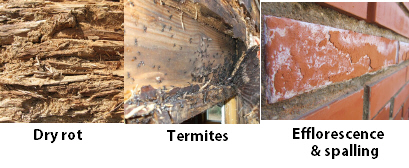
Peeling, blistering, or cracking paint may indicate that moisture is moving through a building material or assembly, damaging the paint and the materials underneath.
Corrosion, oxidation, and rust on metal are unmistakable signs of moisture problems. Deformed wooden surfaces may appear as the damp wood swells, and later warps and cracks as it dries.
Efflorescence is a white, powdery deposit left by water that moves through masonry and leaves minerals behind as it evaporates from the masonry surface. Masonry materials experience spalling with efflorescence that deteriorates their surfaces.
1.6.4 Solutions for Moisture Problems
Preventing moisture problems is the best way to guarantee a building’s durability and its occupant’s respiratory health. However, the solutions get progressively more expensive if simple ones don’t solve the problem.
Inexpensive Moisture Solutions
If moisture source reduction isn’t adequate to prevent moisture problems, try these solutions after preventive measures are in place.
✓ Repair plumbing leaks.
✓ Install a ground moisture barrier. See “Ground-Moisture Barriers” on page 42.
✓ Provide crawl-space ventilation that complies with the requirements of the IRC and SWS. See “Crawl Space Ventilation” on page 449.
✓ Verify that combustion vents, clothes dryers, exhaust fans vent to the outdoors and not into crawl spaces or attics.
✓ Seal water leaks in the foundation.
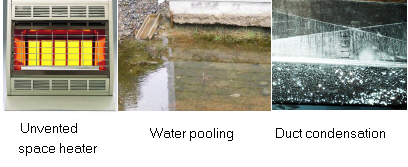
✓ Seal water leaks in the roof.
✓ Remove unvented space heaters, a major source of moisture, from the dwelling.
✓ Educate clients about ways to reduce moisture.
✓ Educate customers to avoid excessive watering around the building’s perimeter. Watering lawns and plants close to the building can dampen its foundation. In moist climates, cut shrubbery back away from the foundation, allowing air to circulate near the foundation.
✓ Insulate air-conditioning ducts to prevent summer condensation.
More Costly Moisture Solutions
Follow these preventive measures before trying any of the solutions in the next section.
✓ Install or improve air barriers and vapor barriers to prevent air leakage and vapor diffusion from transporting moisture into building cavities. See page 547.
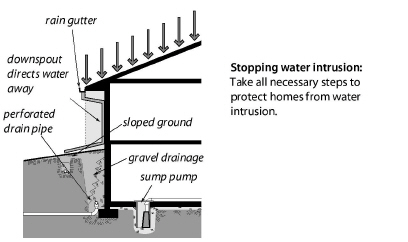
✓ Add insulation to the walls, floor, and ceiling of a building to keep the indoor surfaces warmer and less vulnerable to winter condensation. During cold weather, well-insulated homes can tolerate higher humidity without condensation than can poorly insulated homes.
✓ Ventilate the dwelling with drier outdoor air to dilute the more humid indoor air. Ventilation is only effective when the outdoor air is drier than the inside air, such as in winter. In summer, outdoor air may be more or less humid than indoor air depending on climate, time of day, and whether the dwelling is air conditioned. See "Ventilation" on page 417.
|
SWS Detail: 2.0201.1 Gutters; 2.0201.2 Downspouts; 2.0201.3 Grading; 2.0201.4 Sump Pumps |
Inadequate drainage is an important moisture problem for many buildings. Finish the following tasks before air sealing the floor or installing underfloor insulation, as allowed under DOE guidelines or with non-DOE funds.
Observe these specifications for gutters, downspouts, grading, and sump pumps.
Comply with these specifications when installing or repairing rain gutters.
✓ Install or repair rain gutters as necessary, and verify that downspouts discharge rainwater at least 6 feet away from the building.
✓ Size gutters appropriately for the roof area they drain.
✓ Attach gutters with screws through facia into sub-facia or rafter tails.
✓ Fasten gutter sections together with mechanical fasteners, such a sheet-metal screws or pop rivets.
✓ Slope all gutters toward downspouts a minimum of 1/4 inch per 10 feet.
✓ Make all seams watertight using a compatible sealant, such a butyl caulk. See “Caulking and Adhesives” on page 115.
✓ When replacing whole sections of rain gutters, prefer continuous rain gutters.
Comply with these specifications when installing or repairing downspouts.
✓ Plan the size and number of downspouts, according to the area drained.
✓ Attach downspouts to gutters with mechanical fasteners, such as sheet-metal screws or pop rivets.
✓ Attach downspouts to dwellings a minimum of every 4 feet of their length with appropriate hardware and fasteners.
✓ Assemble downspout sections so that the upper section fits inside the lower section.
✓ Drain downspouts a minimum of 6 feet away from the structure.
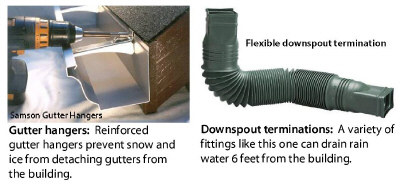
Grading
Comply with these specifications when you can repair grading problems.
✓ Verify that the ground outside the building slopes away from the foundation.
✓ If the ground slopes toward the foundation or water puddles near the building, use topsoil, clean fill, and/or masonry materials, slope ground away from the building at least 6 inches per 10 feet.
✓ Clear all vegetation within 3 feet of the building or trim all vegetation to 1 foot clearance from the building.
Install a Sump Pumps, only if necessary
A sump pump is the most effective remedy when ground water continually seeps into a basement or crawl space and collects there as standing water. Persistent ground-water seepage may only be solved by connecting an interior perimeter drain to the sump.
✓ Suggest a sump pump for crawl spaces or basements with a history of flooding.
✓ Select a sump pump that meets the flow requirements of the home.
✓ Select the most energy efficient pump available. Prefer electrically commutated motors (ECM) when possible.
✓ Locate the sump pump where it collects water from the entire below-grade area and pumps it away from the foundation a minimum of 10 feet.
✓ The sump cover must not interfere with drainage and must be accessible and rigid.
✓ Install sump pumps according to the manufacturer's instructions.
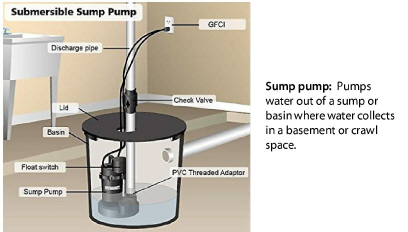
✓ Install a check valve to prevent pumped water from reentering the sump well.
✓ Verify safe operation, and ensure that floats and float switches function correctly.
✓ Provide resident with manufacturer’s operation-and-maintenance instructions.
1.6.6 Drying Buildings with Dehumidifiers
|
SWS Detail: 2.0203.1 Stand-Alone Dehumidifier Installation; 3.0104.1 Closed Crawlspace Air Sealing; 6.0305 Dehumidification; 6.0305.1 Ventilator Dehumidifiers |
As a last resort, remove moisture from indoor air by cooling the air to below its dew point with dehumidifiers in winter and air-conditioners in summer. Using dehumidifiers and air conditioners for drying a building is the most expensive solution. Try all the moisture solutions discussed previously before resorting to a dehumidifier.
Dehumidifier Specifications
The dehumidifier should meet these specifications.
✓ Must be Energy Star or more efficient.
✓ Must have a fan-off option.
✓ Must retain automatic settings after power interruption.
✓ Must be rated for low temperature operation if located in a basement or crawl space.
✓ Must have features that control both peak power and energy use.

Dehumidifier Installation
When you install a dehumidifier, observe these requirements.
✓ Choose a dehumidifier with automatic controls to limit energy and power.
✓ Evaluate the dehumidifier for compatibility with the space where you install it. Read the specs.
✓ Install the dehumidifier in a location that allows free airflow around it.
✓ Pipe the dehumidifier’s collected water to a plumbing drain in a code-approved way.
✓ Seal any penetrations to the exterior of the home created by the dehumidifier’s installation.
✓ Verify that the dehumidifier functions as designed.
✓ Measure the relative humidity in the space before and after completing the installation. Relative humidity should decrease after a few hours of operation.
✓ Verify that the dehumidifier’s relative-humidity measurement is accurate, using a secondary independent measurement.
✓ Give the resident the user guide and warranty information, and explain how to use the dehumidifier.
✓ Show the occupant how to clean or change the filter and how to clean the condensate drain.
✓ Permanently remove old appliance from job site and recycle or dispose of removed appliance and its refrigerant to comply with local and federal law (EPA Section 608 of Clean Air Act of 1990).
1.6.7 Ground-Moisture Barriers
|
SWS Detail: 2.0202 Ground Vapor Retarders; 2.0202.1 Un-Vented Subspaces - Ground Cover; 2.0202.2 Vented Subspaces - Ground Cover; 2.0202.3 Pier and Skirting Foundations - Ground Cover |
Air, water vapor, liquid water, and pollutants move through soil and into crawl spaces and dirt-floor basements. Even if soil’s surface seems tight and dry, the soil may allow a lot of water vapor and soil gases to enter a dwelling.
Cover the ground with an airtight moisture barrier to prevent the movement of moisture and soil gases from the ground into the crawl space. Use these procedures.
Prepare the Ground
✓ The crawl space should have an access hatch or door that is sized adequately for a worker or a resident to enter and exit.
✓ Remove biodegradable matter, such as vegetation, wood, and cardboard, from the crawl space.
✓ Remove all debris that can cause injury or puncture ground moisture barrier, such as nails, wood debris, and sheet metal screws.
✓ Provide negative pressure in the crawl space with reference to the building when dust or vapors might migrate into the living area from the crawl space during weatherization.
Install the Ground-Moisture Barrier
✓ Cover the ground completely with a ground moisture barrier at least 6-mil polyethylene with less than 0.1 perm where little or no foot traffic exists. Install reinforced or cross-linked polyethylene where the barrier will see foot traffic, such as when occupants use the crawl space for storage.
✓ Seams must overlap at least 12 inches. Seal the edges and seams with acoustical sealant, butyl caulking, or construction tape to create an airtight seal between the crawl space and the ground underneath.
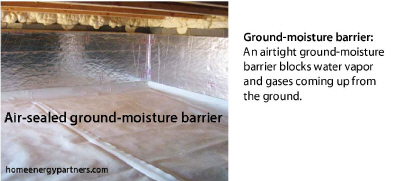
✓ The edges of the barrier should run at least 6 inches up the foundation walls and internal supporting structures. Fasten the barrier with wood strips, masonry fasteners, and sealant., such as polyurethane adhesive or acoustical sealant to a clean and flat masonry surface.
✓ To avoid trapping moisture against wood surfaces, ground moisture barriers must not touch wood structural members, such as posts, mud sills, or floor joists.
✓ The ground vapor retarder must not interfere with the established drainage features such as sump pits or French drains.
✓ Fasten ground vapor retarder to ground with durable fasteners or ballasts when installed on sloping ground, or when people access the space for routine maintenance or storage.
Post a Crawl-Space Sign
Install a durable (minimum of 10-year service life), easily seen sign, sized a minimum of 8.5"x 11" at each access to the space.
Sign must include these items.
✓ Warning to prohibit storage of hazardous and flammable materials.
✓ Caution residents not to damage the ground moisture barrier, air barrier, insulation, or mechanical components specific to the space.
✓ Specify that immediate repairs are necessary in the case of damage.
Radon and asbestos are also important hazards to both occupants and workers.
Radon is a dangerous indoor air pollutant that comes from the ground through rocky soil. The EPA predicts about 20,000 lung cancer deaths per year, caused by radon exposure. Weatherization workers should be aware of: the radon hazard, radon testing procedures, and radon mitigation strategies.
The EPA believes that any building with a radon concentration above 4 pico-Curies per liter (pC/l) of air should be modified to reduce the radon concentration. Health departments and private consultants throughout the U.S. do several common and reliable tests for radon
Weatherization work usually has little effect on radon concentrations. However, ground-moisture barriers and foundation air sealing may reduce radon concentrations in addition to reducing moisture migration and air leakage.
Radon Mitigation
DOE funds can’t pay for fans or other measures specifically designed for radon mitigation. Radon mitigation must use non-DOE funds. Since radon comes through the soil, mitigation strategies include the following.
1. Install a plastic ground barrier and carefully sealing the seams and edges.
2. Seal the walls and floor of the basement or crawl space.
3. Ventilate the crawl space or basement with an exhaust fan to dilute radon.
4. Depressurize the ground underneath the basement concrete slab.
Weatherization workers may install the first two mitigation strategies as prescribed by the weatherization work order for the purpose of air-sealing.
1.7.2 Asbestos Containing Materials (ACM)
The EPA classifies asbestos as a “known carcinogen.” The following materials may contain asbestos: boiler and steam-pipe insulation, duct insulation, floor tile, siding, roofing, some types of vermiculite, and some adhesives. Weatherization workers must recognize asbestos and avoid disturbing it. Penalties for mishandling asbestos-containing materials can amount to $25,000 per day.
DOE weatherization policy requires weatherization agencies to observe the following safety precautions regarding asbestos.
• Asbestos siding comes in sheets approximately 16 inches by 24 inches. It is very weatherproof but very brittle. Remove asbestos siding only if you can remove the siding without damaging it.
• Assume that asbestos is present in old gray-colored pipe insulation and duct insulation. Don’t disturb asbestos-containing pipe or duct insulation.
• Caution occupants to avoid disturbing asbestos.
• Don’t cut, drill, scrape, sand or brush ACM.
• Don’t remove vermiculite. Test vermiculite for asbestos, and use air monitoring if asbestos is present in the vermiculite in a building you’re weatherizing.
• Don’t do a blower-door depressurization test in a building where friable asbestos or vermiculite are present. Unless the suspect material has tested negative for asbestos, do a blower-door pressurization test instead to avoid sucking asbestos fibers into the building.
Contract with certified asbestos testers and abatement specialists to mitigate asbestos problems before or during weatherization, if necessary. Mitigate friable asbestos before doing a blower door test.
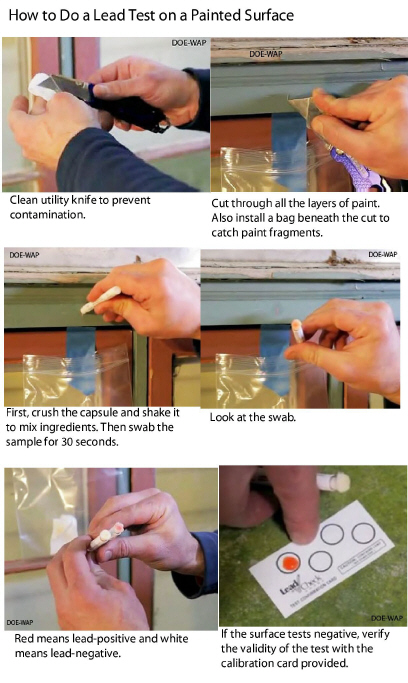
In 2010, The EPA’s Lead-Safe Renovation, Repair, and Painting (RRP) rule became a legal mandate for weatherization work.
Lead dust is dangerous because it damages the neurological systems of people who ingest it. Lead often poisons children in pre-1978 homes because of paint disturbance during building improvement and because children’s hand-to-mouth behavior is common. Lead poisons workers when they inhale lead dust.
Lead paint was commonly used in homes built before 1978. Contractors working on these older homes should either assume the presence of lead paint or perform tests to rule out its presence.

The RRP rule requires lead-safe containment procedures whenever workers disturb painted surfaces of more than 6 square feet of interior surface per room or more than 20 square feet of exterior surface per side. Cutting, scraping, drilling, or other dust-creating activities disturb lead in pre-1978 homes. Disturbing paint on windows and doors always requires containment.
The RRP requires certifications, warnings, dust-prevention, dust collection, and housecleaning as summarized here.
✓ With pre-1978 homes, either test for lead-based paint or assume that lead-based paint is present. See "How to Do a Lead Test on a Painted Surface" on page 47.
✓ Every pre-1978 weatherization or renovation job that has been tested and confirmed that lead is present must be supervised by a certified renovator with 8 hours of EPA-approved training when workers disturb more than the minimum paint area or when they disturb paint on windows or doors.
✓ Renovation firms must be registered with the EPA and employ one or more certified renovators.
✓ Signs and barriers must warn occupants and passersby not to enter the work area.
✓ Floor-to-ceiling dust-tight barriers must prevent the spread of dust from the work area.
✓ Plastic sheeting must protect surfaces and fixtures within the work area.
✓ Workers must clean work surfaces sufficiently to pass an EPA-approved dust-wipe test, conducted by the certified renovator.
✓ Workers must not track dust from the work area into the dwelling.

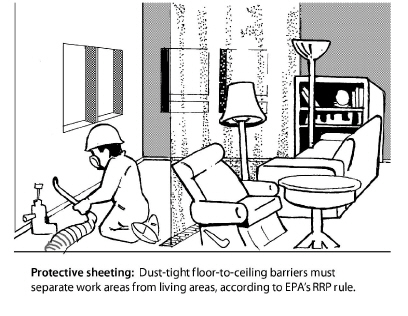
Additional Lead-Safe Work Practices
When engaging in the paint-disturbing activities, follow these lead-safe work practices.
✓ Wear a tight-fitting respirator to protect yourself from breathing dust or other pollutants.
✓ Confine your work within the dwelling to the smallest possible floor area. Seal this area off carefully with floor-to-ceiling barriers made of disposable plastic sheeting, sealed at floor and ceiling with tape.
✓ Don’t use heat guns or power sanders.
✓ Spray water on the painted surfaces to keep dust out of the air during drilling, cutting, or scraping painted surfaces.
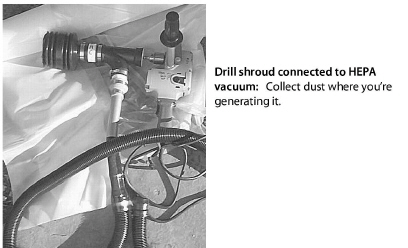
✓ Erect an effective dust-containment system outdoors to prevent dust contamination to the soil around the dwelling.
✓ Use a dust-containment system with a HEPA vacuum when drilling holes indoors.
✓ Avoid taking lead dust home on clothing, shoes, or tools. Wear boot covers while in the work area, and remove them to avoid tracking dirt from the work area to other parts of the building. Wear disposable coveralls, or vacuum cloth coveralls with a HEPA vacuum before leaving the work area.
Wash thoroughly before eating, drinking, or quitting for the day.
|
SWS Detail: 2.03 Electrical; 2.0301 High Voltage (50 volts or more); 2.0301.1 Junctions/Splices Enclosed |
Electrical fires and shocks are common and serious safety problems. Electrical safety is a basic housing need, requiring attention during weatherization and repair.
Observe the following specifications for electrical safety in weatherizing existing buildings.
✓ When any weatherization, health, or safety procedure requires working with line-voltage power, a licensed electrician must do the procedure.
✓ Whenever working around wiring, use a non-contact voltage tester to determine whether circuits are live. Turn circuits off at circuit breakers as appropriate.
✓ Inspect wiring, fuses, and circuit breakers to verify that wiring isn’t overloaded. Maximum ampacity for 14-gauge wire is 15 amps and for 12-gauge wire is 20 amps.
✓ Confirm that all wire splices are enclosed in electrical junction boxes. If you plan to cover a junction box with insulation, attach a flag to mark its location.
✓ Don’t allow metal insulation shields to contact wiring.
✓ Verify that the electrical system is grounded to either a ground rod or to a metallic water pipe with an uninterrupted electrical connection to the ground.
✓ If installing insulation, install S-type fuses where appropriate to prevent occupants from installing oversized fuses.
✓ If installing insulation, perform a voltage-drop test to evaluate the size and condition of hidden wiring on older homes. Use a “Sure Test Branch Circuit Analyzer”, or similar device that measures the voltage drop at full load (15 amps). Voltage drop may not exceed 5%.
✓ When you doubt the safety of a building’s electrical system, use a generator to power insulation blowers and other large power tools.
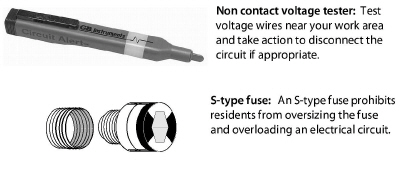
1.8.1 Decommissioning Knob-and-Tube Wiring
Decommission knob-and-tube wiring before or during weatherization if possible. Try to convince your clients or their landlords to replace knob-and-tube wiring with their own funds.
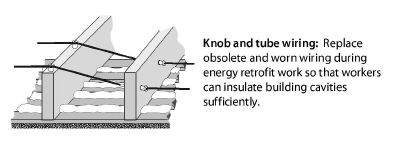
Use a non-contact voltage tester to determine whether the knob-and-tube wiring is live. If you’re unsure about whether the wiring is still live, schedule an inspection by an electrician.
If the knob-and-tube wiring in an attic is live, ask an electrician and/or an electrical inspector to determine whether the attic wiring can be decommissioned and replaced with non-metallic (NM) sheathed electrical cable. Depending on the situation, the electrician may choose one of these two options.
1. Terminate the existing attic knob-and-tube wiring, and connect the new NM circuit directly to the main service box.
2. Install a flagged junction box in the attic to connect the knob-and-tube riser to new NM cable in the attic.
Consider installing a hard-wired CO/smoke detector in a common area near the bedrooms on the new circuit.
1.8.2 Constructing Shielding for Knob-and-Tube Wiring
You may install attic insulation up to the bottom of knob-and-tube wiring, but never cover knob-and-tube wiring with insulation that covers the wires.
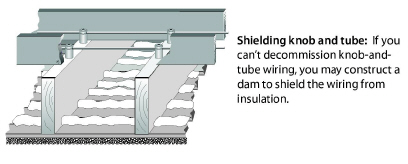
✓ Construct structural dam to maintain a 3-inch clearance between attic insulation and knob-and-tube wiring. Don’t cover the knob-and-tube wiring.
The personal health and safety of each worker is vitally important to every weatherization agency. Injuries are the fourth leading cause of death in the United States. Long-term exposure to toxic materials contributes to workers’ sickness, absenteeism, and death. Both injury hazards and toxic substances exist during weatherization work.
The Occupational Safety and Health Administration (OSHA) establishes workplace safety standards. Weatherization staff and contractors must attend training on OSHA standards and observe these standards on the job. Safety always has priority over other factors affecting weatherization operations.
Some hazards deserve attention because of their statistical danger. Become aware of these most common workplace hazards.
• Vehicle accidents
• Falls
• Back injuries
• Exposure to hazardous materials
• Electrical hazards
• Repetitive stress injuries

Safety requires commitment, awareness, communication, and action. Workers may not remember safe work practices unless employers periodically review safe practices.
✓ Commit yourself to health and safety
✓ Develop awareness of health and safety hazards
✓ Communicate with coworkers about health and safety
✓ Take action to remove health and safety hazards from your workplace
Safety Basics
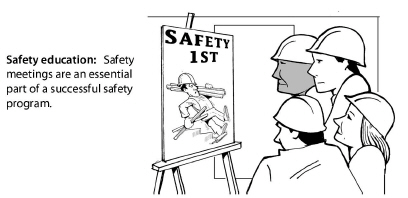
✓ Observe all state and federal standards relating to worker health and safety.
✓ Arrange regular health and safety training.
✓ Conduct monthly safety meetings at headquarters and weekly safety meetings on the current jobsite.
✓ Provide well-equipped first-aid kits in the work vehicles and in the warehouse.
✓ Provide and require personal protective equipment for workers appropriate for their job duties.
✓ Provide a fire extinguisher in the warehouse and each work vehicle.
✓ Keep equipment in good condition.
✓ Keep lists of emergency-contact phone numbers for both employees and emergency services in the warehouse and in the work vehicles.
✓ Keep Safety Data Sheets (SDSs) in a convenient location and tell workers where they are.
New workers are several times more likely to injure themselves on the job compared to experienced workers. Before their first day on the job, new workers should learn about safety basics such as proper lifting, safe ladder usage, and safe operation of the power tools.
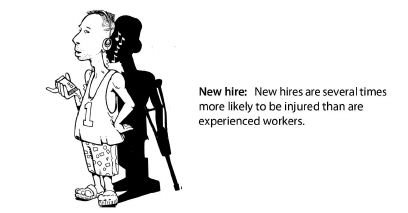
Be sure to inform new employees about hazardous materials they may encounter on the job. Show new hires the Safety Data Sheets (SDS) required by OSHA for each hazardous material they may use.
New employees should be required to use this common safety equipment.
✓ Proper clothing.
✓ Leather gloves with cuffs.
✓ Safety glasses.
✓ Hearing protectors.
Ban alcohol and drugs from agency headquarters and the job. Encourage staff members to refrain from smoking and to stay physically fit.
According to the Bureau of Labor Statistics, one-third of all occupational fatalities in the United States occur in motor-vehicle accidents. Staff members should organize errands and commuting to the job site so as to minimize vehicle travel.
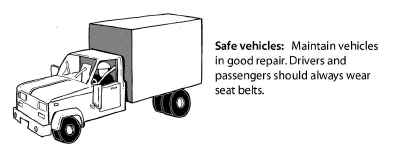
Inspect vehicles regularly and repair them if necessary. Verify that these safety features are present and functioning.
✓ Brake system
✓ Steering system
✓ Horn
✓ Headlights
✓ Rear-view and side-view mirrors
✓ Directional signals
✓ Backup lights
✓ A fire extinguisher
Always wear seat belts. Before traveling to the job, secure tools and materials in the vehicle’s cargo area to prevent shifting.
1.9.4 Lifting and Back Injuries
Back injuries account for one out of every five workplace injuries. Most of these injuries are to the lower back and result from improper lifting, crawling in tight spaces, and using heavy tools.
Workers often injure their backs by lifting heavy or awkward loads improperly or without help. Use proper lifting techniques such as lifting with your legs and keeping a straight back whenever possible.
To protect yourself from back injury do these things.
✓ Get help before trying to lift heavy or awkward loads,
✓ Stay in good physical condition,
✓ Control your weight through diet and exercise.
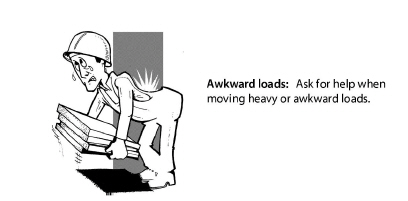
Workers with limited lifting abilities, because of weakness or prior injury, should avoid heavy lifting.
Preventing Back Injury
These policies help prevent back injuries on the job.
✓ Redesign work activities — adapt equipment to minimize awkward movements.
✓ Perform strength-testing of workers, set lifting limits, and provide training for all workers on the causes and prevention of back injuries.
✓ Encourage breaks to prevent workers from being in straining positions for long time periods.
✓ Share the most difficult work among all capable crew members.
Wear your respirator when working in a polluted environment. Common construction dust can contain toxins including lead, asbestos, and chemicals released by drilling, cutting, scraping. Liquid foam, caulking, and solvents release toxic organic vapors that require either organic vapor cartridges or a fresh-air supply.
Fit-Test your Respirator
Test your respirators to be sure they have a good fit.
✓ Check the straps and face piece to be sure they are soft and free of cracks.
✓ Strap on the respirator and adjust the straps to be snug but comfortable.
✓ Close the exhalation valve with a hand.
✓ Exhale gently and check for leaks around the edges.
✓ If there are leaks, adjust or repair the respirator.
Workers with beards, facial scars, and thick temple bars on eyeglasses must use full-face respirators to achieve a good seal. OSHA requires a completed form documenting employees’ fit tests each year.
For more information, see the OSHA Respiratory Protection web pages.
Special Respiratory Hazards
Consider and take action to protect yourself from these special respiratory hazards.
1. When spraying low-pressure polyurethane foam, use an organic vapor respirator cartridge with a P-100 particle filter. Also ventilate the area where you’re spraying the foam.
2. When spraying high-pressure polyurethane foam, use a supplied-air, positive-pressure respirator, and ventilate the work area.
3. Learn how to recognize asbestos insulation that may be installed around older furnaces and boilers. Avoid disturbing asbestos in any way.
4. Control dust in your client’s homes by erecting temporary barriers when you’re doing work that may release dust.
5. Wear coveralls when entering attics or crawl spaces. Coveralls should be disposable or professionally laundered.

Hazardous materials threaten your health and safety on the job. Workers often fail to protect themselves from hazardous materials because they don’t recognize the hazards. Breathing hazardous materials, absorbing them through the skin, and coming into eye contact with hazardous materials are common ways dust and chemicals injure workers.

OSHA regulations require employers to notify and train employees about hazardous materials used on the job. Obtain copies of Safety Data Sheets (SDSs) from manufacturers or their distributors. Employers must make SDS for every workplace hazardous material readily available to workers.
Inspect the work site to identify hazardous materials and to plan how to avoid the hazard.
Learn how to handle hazardous materials used on the job. Use the personal protective equipment (PPE) that is recommended by the SDS.
For more information, see OSHA’s Hazard web pages.
1.9.7 Equipment for Personal and Crew Safety
Workers should have their own personal protective equipment.
• Respirators with dust and organic-vapor cannisters
• Clean cloth coveralls or disposable coveralls
• Gloves
• Safety glasses
• Hearing protection
• Hard hat for head-injury hazards
Crews should equip themselves with the safety equipment listed here.
• Ladder levelers and stabilizers
• Portable lights for work in dark areas
• A water jug
• Insect spray
• Safe, heavy electrical cords with GFCI or AFCI receptacles as required locally
Falls off ladders and stairs cause 13% of workplace injuries according to the National Safety Council. Other falls from the heights account for approximately 7% of workplace injuries.
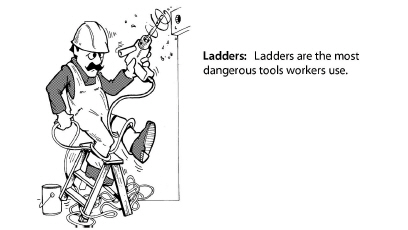
Broken ladders and unstable ladders are both major causes of on-the-job falls. Step ladders, for instance, are often used for work that is too far off the ground, forcing workers to stand on the top step or to reach too far.
Guidelines for Ladders
OSHA regulations include these important guidelines for ladder use.
✓ Avoid metal ladders.
✓ Maintain all ladders in good repair, and replace ladders if they have missing or damaged steps, cracked side-rails, or damaged feet.
✓ Extend extension ladders at least three feet above the area they access.
✓ Ladders shouldn’t have a pitch steeper than four feet of rise for each foot that the ladder’s feet are away from the building.
✓ Block or tie ladders firmly in place at the top and bottom if you install the ladder at a steeper angle than suggested above or on windy days.
✓ Don’t use metal ladders where they may accidentally touch electrical conductors.
✓ Maintain ladders free of oil, grease, and other slipping hazards. Inspect your shoes for slipping hazard before climbing a ladder.
✓ Don’t over-reach — instead move the ladder.
✓ Avoid carrying heavy loads up ladders and operating power tools from ladders.
Build scaffolds when working above-ground for sustained time periods. Stabilize each scaffold leg so that it supports an equal weight as other legs. Secure planks to the structure and provide handrails on the sides and ends of walkways.
Housekeeping
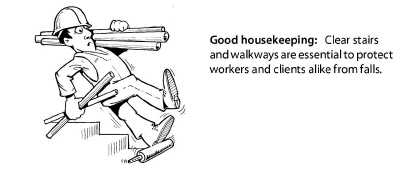
Workers should inspect their workplaces regularly to notice and remove slipping and tripping hazards. Workers carrying loads should create and maintain debris-free walkways.
The tools used in construction work are dangerous if used improperly. About 90,000 people hurt themselves with hand tools each year. The crew chief should conduct tool-safety training as frequently as necessary to insure safe tool use.
These basic safety rules can reduce the hazards of using hand and power tools.
✓ Use the right tool for the job.
✓ Keep all tools in good condition with regular maintenance.
✓ Inspect tools for damage before using them.
✓ Operate tools according to the manufacturer’s instructions.
✓ Wear appropriate personal protective equipment.
✓ Use double insulated power tools or ground-fault-circuit-interrupter (GFCI) outlets or GFCI extension cords to prevent electric shock.
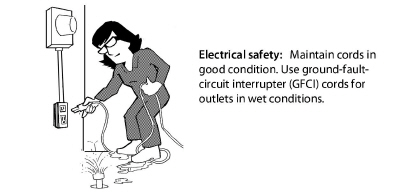
✓ Use generators for electrical service on the jobsite and ground them. Exhaust gases must not enter indoor spaces or pollute the outdoor air near workers.
✓ Use three-wire electrical cords without worn or frayed jackets.
✓ Verify that generator exhaust is directed away from the building, the vehicle, and the crew.
1.9.10 Repetitive Stress Injuries
Repetitive stress injuries are caused by over-working certain parts of your body. Poor body posture, such as reaching above your head when operating a power drill, can encourage these injuries. Good work habits prevent this type of injury.
✓ Use a comfortable arm and hand posture when operating tools for a long period of time.
✓ Change the angle and location of your work surface frequently.
✓ Mix your difficult tasks with easier ones.
✓ Carry smaller loads.
✓ Take short rest breaks periodically, and stretch any tight muscles during this time.
When you purchase hand and power tools, look for models with ergonomic designs that place less stress on your body.
1.9.11 Safety for Crawl Spaces and Other Confined Areas
The Occupational Safety and Health Administration (OSHA) defines a confined space as a space that contains a hazard like confinement, limited access, or restricted airflow because of its small size.
Access to Confined Spaces
Employers must be aware of the hazards of confined spaces and have policies for protecting workers. Consider these steps when appropriate.
✓ Remove contaminants such as sewage, dead animals, rotting leaves, etc. before inspecting or working in the crawl space.
✓ The crawl space should have an access hatch or door that is sized adequately for a worker or a resident to enter and exit.
✓ Workers should identify access and egress points before entering a confined space.
✓ If a heating and cooling system is located in the crawl space, the crawl space must have an access hatch or door measuring 22 inches by 30 inches or big enough to remove the heating and cooling system, whichever is greater.
Chemicals in Confined Space
Observe these requirements when using chemicals in confined spaces.
✓ At minimum, workers using any type of chemical in a confined space must employ continuous powered ventilation using adequately sized openings to facilitate airflow into and out of the confined space.
✓ If workers use chemicals in significant quantities, such as spraying of two-part polyurethane foam, the workers should wear respirators that supply fresh air.
✓ If a confined space contains a hazard like chemical vapors or the potential to collapse or trap a worker, the space is called a permit-required confined space (PRCS). A worker must have a permit to enter the space and workers without permits must not enter. The permitted workers must have special training and equipment to enter the confined space.
1.9.12 Safety in Extreme Weather
Extreme weather is a common cause of job-related sickness and injury. You can avoid sickness and injury by awareness and preventive measures.
Hot-Weather Safety
Know the signs of heat ailments and take action if you or a co-worker experiences the beginning of symptoms. Observe these hot-weather suggestions for staying cool and preventing heat ailments.
✓ Drink plenty of water and take salt tablets.
✓ Ventilate attics with fans.
✓ Rotate workers in attics to prevent heat exhaustion.
✓ Use water or ice to cool your skin if you experience heat stress.
✓ Rest when you feel fatigued.
Cold-Weather Safety
Workers and supervisors should know the temperature, wind speed, and precipitation forecast. Dress for extreme cold and plan work around storms and other extreme weather events.
✓ Dress in layers for comfort and changing temperatures.
✓ Wear insulated boots or heavy socks.
✓ Wear insulated gloves.
✓ Seek warm shelter if you experience numbness or uncomfortable chilling.
Windy-Weather Safety
Be aware of the forecast for windy weather and take precautions before beginning work and before the wind blows.
✓ Tie ladders off high and anchor them low.
✓ Avoid carrying sheet goods that could act as a sail allowing the wind to blow you over.
✓ Store materials and tools where the wind can’t move them.